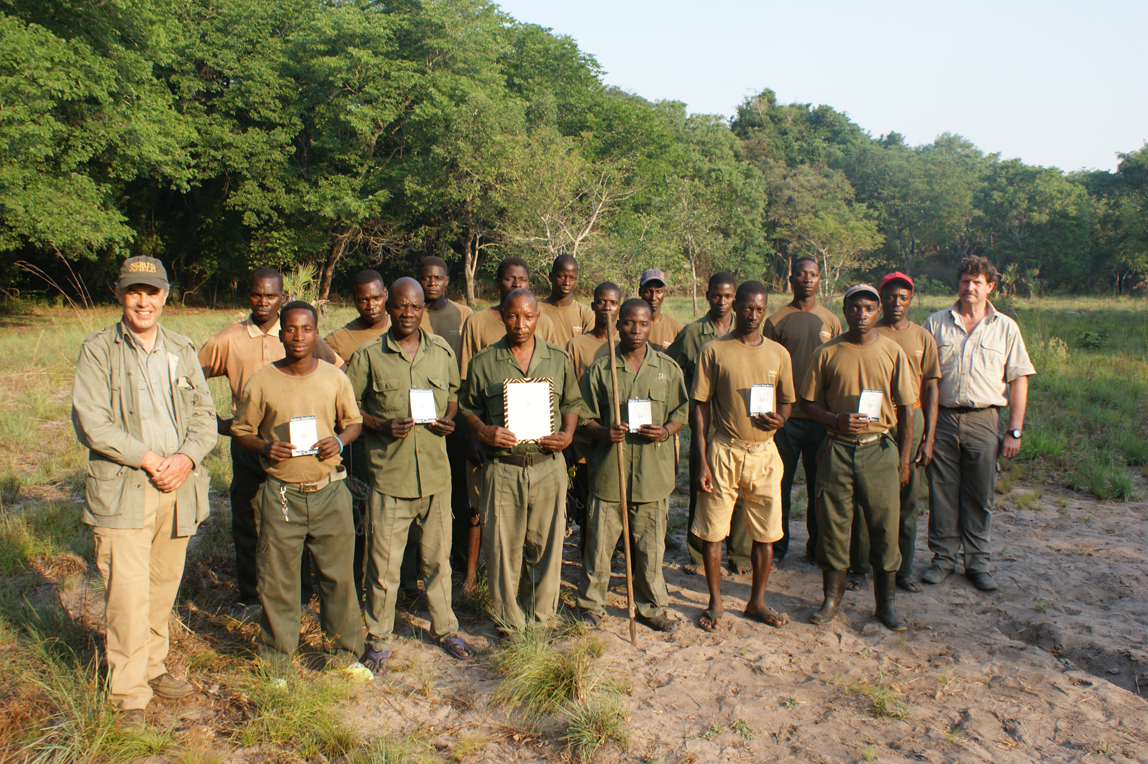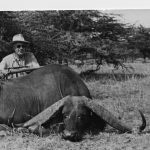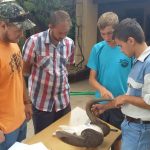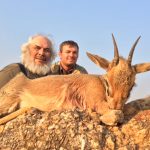A recent visit to Coutada 10 provided an up-close look at one safari company’s efforts to deter poachers.
Above: The anti-poaching teams at Mozambique’s Marromeu Safaris gather for a group photo after the Rowland Ward-sponsored snare-finding contest.
Recently a member of the Rowland Ward staff was on a hunt in Mozambique, with two other hunters, looking for buffalo along the south side of the Zambezi River with Marromeu Safaris (Coutada 10). While in camp, they noticed the anti-poaching efforts headed by Willem Scheepers of South Africa, who commands a crew of 28 employees to combat wildlife thieves. Their efforts are intense and consist of three teams that patrol various sections of the concession, which is over half a million acres in size. A huge swath of land that abuts the Indian Ocean and the Marromeu Reserve, this concession is so large that patrols looking for poachers need to stay out for days at a time, sleeping in the bush.
The area is divided into zones to systematically co-ordinate anti-poaching activities and keep the poachers guessing where the patrols will be next. While the romantic view of anti-poaching may be an image of tough hombres shooting it out with greedy ivory killers, the reality is more like police work in a big city; loads of planning, paperwork, coordinating with wildlife officials, and plenty of time spent with “feet on the ground,” searching for signs of criminal activity; physical confrontations are rather scarce. When poachers do get caught, they are handed over to the wildlife authorities.
Much of the anti-poaching efforts concentrate on removal of snares and traps, checking for illegal burning, and, most important, creating a constant presence of humans to discourage wildlife criminals in the area. Despite the fact that we as hunters care very much about the large mammals in a given area, anti-poaching is often concentrated on illegal fishing (it leads to other wildlife violations), and stopping habitat destruction in the form of timber poaching and food plot clearing via illegal burning. All of these seriously impact wildlife, and need to be checked whenever possible.
After spending a few hours with the anti-poaching team, Rowland Ward decided to spontaneously sponsor a snare removal contest. Scheepers would let each of the three teams pick a zone of their choosing to police for three days to recover snares; the team with the most snares found would get a cash prize.
The hunters came back to the anti-poaching compound three days later to be surprised by the large amount of snares that had been removed. The winning team had 53 snares while the runner up had 38 and the third team 27. In addition, several gin traps (similar to the Conibear) had been unearthed. Because no point system had been assigned to the snares verses the metal gin traps, the exact “value” of the recovered devices was somewhat murky, so it was decided that all teams would get cash prizes with the team with the most snares getting a bonus. Rowland Ward was the sponsor of this contest and the photos show the teams holding Rowland Ward brochures and stickers in appreciation of their rewards.
The highlight of the afternoon was yet to come when Sheepers and the captains of the three patrols gave the hunters a demonstration of how the traps worked, from large snares big enough to catch a zebra or hartebeest, to medium snares to catch warthog-size animals, to tiny snares to catch birds such as guinea fowl. It was educational to see how a primitive trap made out of nothing but a nylon string and a bent sapling can be so effective; in this case, the Hollywood version of a snare hidden on the ground that catapults an innocent victim up in the air comes pretty close to the truth.
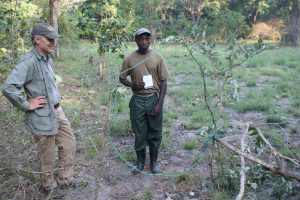
A member of the anti-poaching team demonstrates the use of a simple snare of the type used by poachers. This one is large enough to catch a big-game animal.
A couple of snares and gin traps were set off by poking a stick in them to show the results. To set a gin trap, a 10-foot pole of 8 inches in diameter is needed to leverage the jaws open by two or three adults, and once the trap is set it is carried into the field and carefully buried. Made from the leaf springs of trucks, they have so much tension that their impact can break the leg of a large mammal when triggered.
Marromeu is actively working with the local communities as a well-managed safari area must in modern Africa; all meat not consumed in the hunting camp is distributed among the local population to discourage poaching. A water well, clinic, and a small school with supplies have been built on the edge of the concession to encourage local indigenous people to stay in one area and not roam throughout the concession. Community outreach works with village elders to get the message across that hunters mean meat, money, and employment, and hunters only show up if there are animals in the area. The conservation efforts by this safari company have been great ones, and the results show; the concession is teeming with game. The hunters saw hundreds of warthog, sable, waterbuck, reedbuck, buffalo, and hartebeest as well as healthy numbers of three different duikers, nyala, eland, zebra, and a great many game birds.

